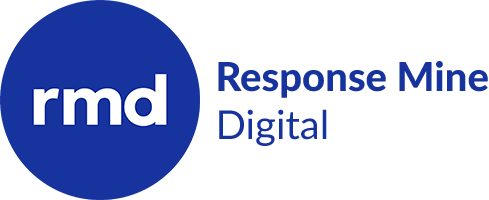
Strategic thinking powered by data science analytics
Growth isn’t just a goal — it’s a science, powered by strategic planning, inspired by creative thinking, and sustained with continuous experimentation.
Other agencies focus on engagement and brand to drive traffic to websites. At Response Mine Digital, our view is that this simply isn’t enough to get the job done right. That’s why we’ve mastered the discipline of growth and have it infused with a deep understanding of direct response strategy and marketing principles.
We’ve been eating, sleeping, and breathing direct marketing for decades. When you combine this with our with custom-built analytics programs, you get instant access to a complete range of data-driven tools that help you make better decisions, including how much to spend and where.
Leave no decision unanalyzed
Research, data, and insights serve as the foundation for every marketing plan we craft. By harnessing these valuable resources, we gain a deeper understanding of consumer behavior and can even forecast future trends. This not only enables us to make informed decisions for optimization across all touchpoints, but also helps us ensure that every interaction resonates with your target audience.
The RMD Way
At the core of our approach is a holistic strategy that aims to captivate
and engage your desired audience on various digital channels.
We begin by articulating the unique identity and personality of your brand, carefully selecting
the most effective methods for consumer engagement. From there, we execute meticulously planned
campaigns and rigorously measure their success to continuously enhance your return on investment.
At the core of our approach is a holistic strategy that aims to captivate and engage your desired audience on various digital channels.
We begin by articulating the unique identity and personality of your brand, carefully selecting the most effective methods for consumer engagement. From there, we execute meticulously planned campaigns and rigorously measure their success to continuously enhance your return on investment.
Assess and optimize every step of the way
This systematic approach will help you assign credit to various marketing touchpoints or channels that contribute to desired customer actions or conversions.
This analytical technique will help you determine the optimal allocation of budget across different media channels to maximize marketing effectiveness and achieve desired outcomes.
Analyzes your customer data and behavior to identify the likelihood or propensity of prospects to make a purchase so you can better target your marketing efforts more effectively.
Categorizes your customers based on their recency, frequency, and monetary value of their purchases so you can tailor marketing strategies to different customer segments.
Analyzes your customer retention and attrition rates so you can better understand the patterns and factors influencing customer loyalty, or churn, and develop strategies to retain your most valuable customers.
Examines your customer data and behavior to predict or determine the likelihood of specific actions, such as making a purchase, subscribing to a service, or engaging with a particular marketing campaign.
Analyzes groups of customers who share common characteristics or behaviors over a specific period, providing you with insights into your customer behavior trends and enabling targeted marketing strategies.
Helps you gain a better understanding of the availability and capacity of inventory or products to meet customer demand, influencing the timing and fulfillment of orders.
A location-based technology that creates virtual boundaries or perimeters around specific geographical areas so you can trigger targeted actions or notifications when your customers enter or exit those areas.
Examines the effects of online marketing or advertising efforts on driving offline conversions, such as in-store visits or purchases, providing you with insights into the effectiveness of digital campaigns in driving offline business.
Assesses the incremental impact of marketing investments by comparing the outcomes or performance of a group exposed to marketing efforts against a control group that was not exposed so you can understand the additional value generated by marketing activities.
Gives you a view of a specific period or duration during which certain products, services, or marketing campaigns experience higher or lower demand due to seasonal factors or trends.
Examines the actions and behaviors of leads after they have expressed interest or provided contact information so can understand lead quality, conversion rates, and identifying areas for improvement in the lead nurturing process.
Involves identifying and analyzing individuals or groups who share similar characteristics, behaviors, or interests to a target audience so you can expand your reach and target new potential customers who resemble your existing customer base.
Measures the sensitivity of demand or consumer behavior to changes in price, income, or other variables, providing you insights into how changes in these factors impact sales or market dynamics.
Uses your historical data, statistical models, and other factors to make predictions or projections about future outcomes or scenarios so you can plan and make informed decisions.
Examines the performance and effectiveness of your marketing efforts across multiple channels or platforms so you can understand how different channels contribute to overall success and optimize their marketing strategies accordingly.
Evaluates the effectiveness and impact of various marketing elements, such as product, price, promotion, and distribution, on your overall business performance and customer behavior.
Analyzes the usage, redemption, and impact of coupons or promotional offers on consumer behavior so you can assess the effectiveness of coupon strategies and identify trends in customer response.
Looks at the point at which additional investments or efforts in marketing or other areas result in diminishing incremental returns so you can optimize resource allocation and identify the optimal level of investment for maximum effectiveness.
This systematic approach will help you assign credit to various marketing touchpoints or channels that contribute to desired customer actions or conversions.
This analytical technique will help you determine the optimal allocation of budget across different media channels to maximize marketing effectiveness and achieve desired outcomes.
Analyzes your customer data and behavior to identify the likelihood or propensity of prospects to make a purchase so you can better target your marketing efforts more effectively.
Categorizes your customers based on their recency, frequency, and monetary value of their purchases so you can tailor marketing strategies to different customer segments.
Analyzes your customer retention and attrition rates so you can better understand the patterns and factors influencing customer loyalty, or churn, and develop strategies to retain your most valuable customers.
Examines your customer data and behavior to predict or determine the likelihood of specific actions, such as making a purchase, subscribing to a service, or engaging with a particular marketing campaign.
Analyzes groups of customers who share common characteristics or behaviors over a specific period, providing you with insights into your customer behavior trends and enabling targeted marketing strategies.
Helps you gain a better understanding of the availability and capacity of inventory or products to meet customer demand, influencing the timing and fulfillment of orders.
A location-based technology that creates virtual boundaries or perimeters around specific geographical areas so you can trigger targeted actions or notifications when your customers enter or exit those areas.
Examines the effects of online marketing or advertising efforts on driving offline conversions, such as in-store visits or purchases, providing you with insights into the effectiveness of digital campaigns in driving offline business.
Assesses the incremental impact of marketing investments by comparing the outcomes or performance of a group exposed to marketing efforts against a control group that was not exposed so you can understand the additional value generated by marketing activities.
Gives you a view of a specific period or duration during which certain products, services, or marketing campaigns experience higher or lower demand due to seasonal factors or trends.
Examines the actions and behaviors of leads after they have expressed interest or provided contact information so can understand lead quality, conversion rates, and identifying areas for improvement in the lead nurturing process.
Involves identifying and analyzing individuals or groups who share similar characteristics, behaviors, or interests to a target audience so you can expand your reach and target new potential customers who resemble your existing customer base.
Measures the sensitivity of demand or consumer behavior to changes in price, income, or other variables, providing you insights into how changes in these factors impact sales or market dynamics.
Uses your historical data, statistical models, and other factors to make predictions or projections about future outcomes or scenarios so you can plan and make informed decisions.
Examines the performance and effectiveness of your marketing efforts across multiple channels or platforms so you can understand how different channels contribute to overall success and optimize their marketing strategies accordingly.
Evaluates the effectiveness and impact of various marketing elements, such as product, price, promotion, and distribution, on your overall business performance and customer behavior.
Analyzes the usage, redemption, and impact of coupons or promotional offers on consumer behavior so you can assess the effectiveness of coupon strategies and identify trends in customer response.
Looks at the point at which additional investments or efforts in marketing or other areas result in diminishing incremental returns so you can optimize resource allocation and identify the optimal level of investment for maximum effectiveness.
